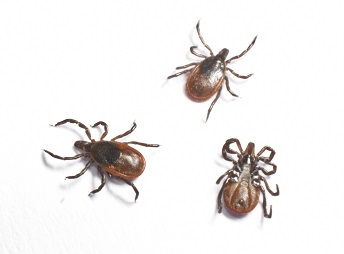
A tick identification guide
Nobody wants to find a tick on themselves, their children or a family pet. Ticks, small insects in the Acari order, are found around the world. There are more than 850 known species, 90 of which are found in the United States. Identifying ticks down to the species usually requires an entomologist. However, the basics of tick identification can help you know if you’re looking at a tick, or another outdoor pest. If you have been bitten by a tick and begin feeling ill, tick identification is key to receiving the proper treatment.
WHAT DO TICKS LOOK LIKE?
Most tick larvae are the size of a grain of sand; nymphs are roughly the size of a poppy seed or sesame seed and unfed adults are the size of an apple seed or a pencil eraser. They do not have wings, and they are flat and oval in appearance until they have had a blood meal. Nymphs and adults will have eight legs, but tick larvae only have six. Ticks can be grayish-white, brown, black, reddish-brown or yellowish in color. Ticks are capable of biting at all three of their active life stages: larval, nymph and adult.
HAVE YOU RECENTLY SPENT TIME OUTDOORS IN AREAS WITH HIGH BRUSH OR GRASS?
Ticks are most often found in areas that are wooded, brushy or have tall weeds and grasses. If you notice a bite after being in these areas, it may have been a tick. They climb up the grass or brush and wait for an animal — including a person — to pass them. Additionally, peak tick season for most of the United States runs from April through July, though ticks are active in winter as well.
ARE YOU SEEING SMALL, ENGORGED INSECTS ON FAMILY PETS?
The American dog tick and lone star tick are both commonly found on dogs, small mammals and livestock. These species of ticks have been known to transmit spotted fever and Rocky Mountain spotted fever. If a bite occurs too close to an animal’s spine, paralysis can occur.
ARE THERE SMALL DARK SPOTS ON YOUR LEGS, PANTS OR SOCKS?
Ticks crawl upwards onto hosts, beginning at the lower leg and wandering until they find a good spot to attach. If you see small spots on your clothing after being outside, they are likely ticks. The Entomology Department at the University of Kentucky recommends taking a warm, soapy shower after any potential exposure. Remove and wash clothing in hot, soapy water to kill any ticks present. If you can’t wash the clothes right away, store them in a sealed bag. Once on a host, most ticks will crawl toward warm, dark areas such as armpits, your groin and head. Many species remain on a host for at least 24 hours. The sooner you find and remove a tick, the lower your risk of contracting a tick-borne disease. If you suspect you have a tick or tick bite and are concerned, contact a medical professional.
IS THE INSECT ON YOU MISSING A HEAD?
Because of the way they feed, ticks can appear headless when you notice them on yourself or your pets. This is because their face is made up of multiple parts that are used to siphon blood into their system. They also become misshapen and distorted when they are taking in a blood meal, which can make tick identification difficult. According to the Centers for Disease Control, removal is best accomplished using a pair of tweezers to gently grab as close to the head as possible, and then slowly drawing the tick backward away from the flesh.
Now that you know some ways to identify ticks, you should check your pets – and your yard – for these pests. If you come across them, it may be time to call Terminix to discuss your options for tick control.
Tick Identification Resource
- The Difference Between Deer Tick and Wood Tick
- How to Spot an Engorged Tick?
- Small Red Ticks: What Are They?
- Bugs That Look Like Ticks: Similar Pests



